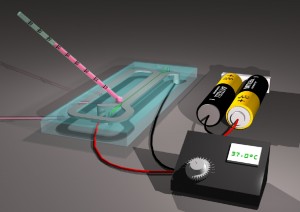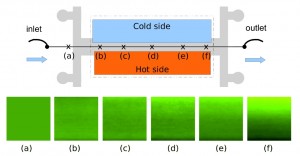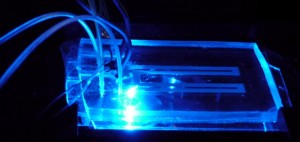With the term “microfluidic” we refer to the study and manipulation of fluids that can flow along small channels with typical transversal size of tenth of microns. Microfluidic lab-on-chip devices are usually designed to mimic on a much smaller scale operations performed in a standard laboratory, with the significant bonus of greatly reducing the amount of sample and the time needed to perform a specific task.
A few notable contributions from our group
A portable device for temperature control along microchannels
 For many physical, chemical and biological measurements, temperature is a crucial parameter to control. In particular, the recent development of microreactors and chip-based technologies requires integrated thermostatic systems. However, the requirements of disposability and visual inspection of a device under a microscope cannot accommodate equipment such as external heaters. By exploiting a silver-filled epoxy that can be injected and solidified in a microfluidic chip, we demonstrate a simple and inexpensive design of a conductive path, which allows heating by the Joule effect of both sides of a microchannel. In addition to permitting the maintenance of a constant temperature along the channel walls, our method can control the temperature gradient across the channel, thus enabling nonequilibrium studies in a microfluidic geometry.
For many physical, chemical and biological measurements, temperature is a crucial parameter to control. In particular, the recent development of microreactors and chip-based technologies requires integrated thermostatic systems. However, the requirements of disposability and visual inspection of a device under a microscope cannot accommodate equipment such as external heaters. By exploiting a silver-filled epoxy that can be injected and solidified in a microfluidic chip, we demonstrate a simple and inexpensive design of a conductive path, which allows heating by the Joule effect of both sides of a microchannel. In addition to permitting the maintenance of a constant temperature along the channel walls, our method can control the temperature gradient across the channel, thus enabling nonequilibrium studies in a microfluidic geometry.
Publications:
D. Vigolo, R. Rusconi, R. Piazza, and H. A. Stone. A portable device for temperature control along microchannels. Lab Chip, 10(6):795–798, 2010.
Microfluidics Separator: an application of Thermophoresis
 We show that thermophoresis, i.e., mass flow driven by thermal gradients, can be used to drive particle motion in microfluidic devices exploiting suitable temperature control strategies. Due to its high sensitivity to particle/solvent interfacial properties, this method presents several advantages in terms of selectivity compared to standard particle manipulation techniques. Moreover, we show that selective driving of particles to the cold or to the hot side can be achieved by adding specific electrolytes and exploiting the additional thermoelectric effect stemming from their differential thermal responsiveness.
We show that thermophoresis, i.e., mass flow driven by thermal gradients, can be used to drive particle motion in microfluidic devices exploiting suitable temperature control strategies. Due to its high sensitivity to particle/solvent interfacial properties, this method presents several advantages in terms of selectivity compared to standard particle manipulation techniques. Moreover, we show that selective driving of particles to the cold or to the hot side can be achieved by adding specific electrolytes and exploiting the additional thermoelectric effect stemming from their differential thermal responsiveness.
Publications:
D. Vigolo, R. Rusconi, H. A. Stone, and R. Piazza. Thermophoresis: microfluidics characterization and separation. Soft Matter, 6(15):3489–3493, 2010

